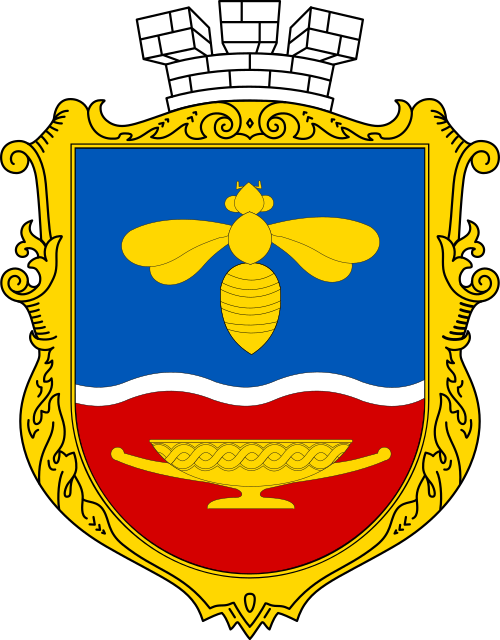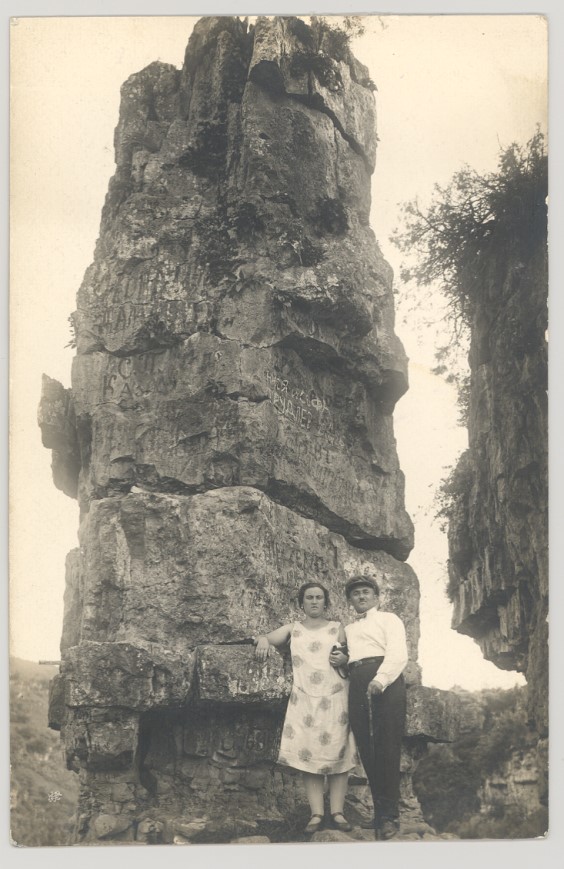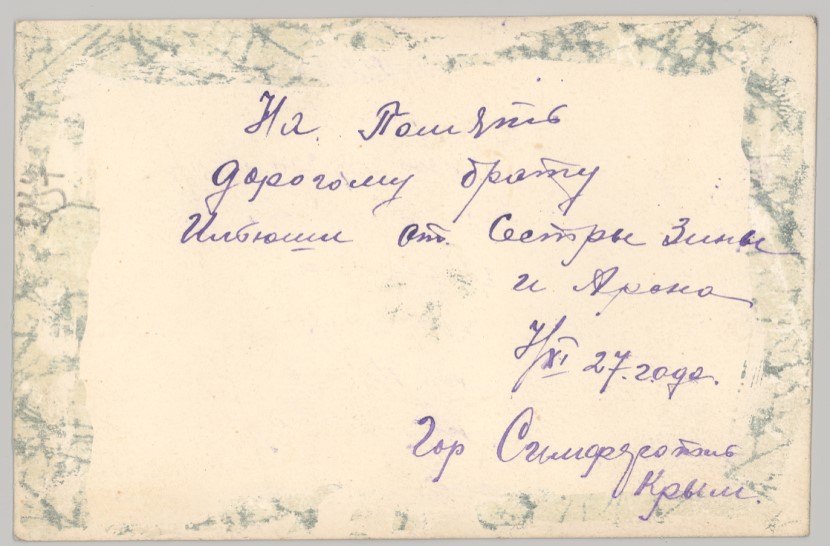
Сімферополь Coordinates: 44° 57' 25.88" N 34° 06' 38.84" E 
|
||

Сімферополь Coordinates: 44° 57' 25.88" N 34° 06' 38.84" E 
|
||
| Home | Maps | (RESERVED) | Links | Census |
My wife’s grandfather, Avraham Norman, along with his two daughters, Edna and Sara, left Vilyeka, Belarus by train, bound for Russia, in 1941 to escape the Nazis.
We now know that they traveled to, and stayed for the rest of World War II, in Petrivka Kolkhoz, near Simferopol. After The War, they returned to Vilyeka,
discovered that they no longer had a home and that they were not welcome; they continued on to Poland.
Edna went to Klosova Kibbutz, a leading kibbutz in Poland that prepared pioneers seeking emigration to Palestine. There, she met and married Arie Semiatitsky. Upon completion of their hachshara (vocational training program), they met a shaliach (legal agent) representative from Kibbutz Alonim, emigrated to Palestine, and lived on Kibbutz Alonim until their deaths. Two of their children still live on Kibbutz Alonim.
Avraham Norman and Sara traveled over the Alps to Italy, at least partially on foot. Avraham died and is buried in the Jewish Cemetery in Milan. Sara went to Rome to make arrangements for her father's burial, where she met and married Reuven Kaplan at the Jewish refugee transfer camp at Castle Gandolpho. They then traveled to Palestine, arriving soon after the State of Israel was declared.
Reuven was originally from Kaunas, Lithuania. He spent at least part of the war in Dachau Concentration Camp. After the war he worked for the American Jewish Joint Distribution Committee (JOINT) in Italy, where he arranged getting Jewish refugees on ships to Palestine. Sara and Reuven lived in Haifa until their deaths. One of their daughters and that daughter’s children and grandchildren still live in Haifa.
My Lithuanian paternal grandfather, Nathan Ze’ev Segal, was probably buried in Genichesk, Crimea after his death there from cholera in 1921/2. He was one of between 150,000 and 250,000 Jews driven from Lithuania in 1915/16, with some members of his family to wander 'aimlessly like a flock of sheep' within the heartland of Russia. [p. 120, The Shtetl: Myth and Reality, ed: A Polonsky: Littman Library]
That some of my immediate family escaped that Crimean exile via Riga in around 1927 is my great good fortune, as eight members of the family, including my grandmother and my father, who was age 19, landed up in South Africa in 1928.
Eliezer Aremband lived in a shtetl (a small Jewish town) within the larger town of Linkuva, in Lithuania. He was a scholar, and used to study Gemara every afternoon from Mincha (afternoon prayers) until Ma’ariv (evening prayers). He was so learned in the Torah that at his funeral he was praised by three Rabbis who delivered a Hesped (funeral oration) because of his great learning.
He had a daughter named Sarah Leah bat Eliezer Aremband.
Nathan Ze’ev Segal HaLevi was born in the shtetl of Pasvitin(ys), north-west of Linkuva. He was a butcher who owned a combined butchery, bakery, and grocery shop, located in one building. The people of Pasvitin usually made their purchases in the shop ‘on credit’. Many local people had family in America or South Africa, and these emigrants would send money from abroad home to their families; debts were paid at the times of every Jewish festival - “yom tov”. Nathan Segal also lent money through ‘Star Ishai’ – a bill that meant that Jews were able to charge interest.
Nathan’s education was an ordinary ‘cheder’ Jewish education. He was taught the prayers, studied ‘tanach’ (bible studies), and ‘gemara’ (Talmud) and also learnt the skill of removing certain veins from slaughtered kosher animals, which meant that certain cuts of meat normally considered ‘treyf’ were rendered kosher.
He met his wife, Sarah Aremband, in Linkuva. She was a tall, beautiful blue-eyed woman and was working in her garden when he first saw her. Nathan was a tall man with fair hair, a ginger beard and blue eyes. They married in about 1896 and settled in Pasvitin.
Two of their sons, Isaac (Issy) and Matthew (Mattes – Matisyahu) used to buy cattle, which they drove a distance of forty miles to the cities of Siauliai (Shavel) or Mietov (Mitau) where they sold them to Zev, a German who manufactured bully-beef for the German Government.
Every man over the age of 21 had to serve Czar Nicholas in the Lithuanian army. Issy, the eldest son, was eligible for army service, but managed to escape to South Africa. He took his sister Mary (Matthew’s twin sister) with him.
In 1915, thousands of Jews (between 150,000 and 250,000 according to records) were driven out of Lithuania. The government accused them of spying for Germany and sent them to Russia. Nathan and some of his family was sent southwards, to a ‘Gubernia’ – a state on its own – Mogilev, in Podolia. Nathan and Sarah, together with their eldest son and his family (Mattes and Golde), two daughters (Feige and Leah), and two sons (Morris and Sam) travelled by train in cattle cars.
Once off the train, they were taken straight to the shul (synagogue) in Mogilev. The government sent farmers with horses and carts to transport the Jews to Chause (?), a day’s journey away. There, Jewish families rented out rooms in their houses at low rates. The Segal family had two rooms in the house of the Polokov family, where the breadwinner was a dentist. In the shtetl of Chause, Sam attended the Trade School, where he learned to work with iron, and he became a government farrier. The family left Chause after about two years.
Nathan had no employment in Chause, so the family went to Tula, southwest of Moscow, where he worked for Jewish building contractors who built barracks for the government. He had no permit to work in Tula but he was aided by the Jewish Board of Tula, who obtained permission from the government for him to work there. Tula was a large city with a population of about one million people, where the Jews lived in a shtetl, Chulkova.
The family stayed in Tula for two years.
The winters were bitterly cold and Nathan wrote to friends in the Ukraine who wrote back telling of the good weather and better living conditions there (no food shortages), and the possibility of a better income for the family. So, in 1916, Nathan took the train southwards, going alone to the Ukraine to see if it was a suitable place for the family to move to. No permission was required to move to the Ukraine, so the family left for the town of Genichesk on the shores of the Sea of Azov. There was a large community who were primarily engaged in wheat-farming.
Nathan bought a house and bought provisions from the open markets. Because Genichesk was a port-town with no shtetl, many Jews were wealthy and lived in the best parts of town. The majority of the Jews were merchants and agents who bought wheat from the farmers and sold it to the mills in order to make a profit.
When the Segal family arrived in Genichesk, they were welcomed with a good meal.
One market sold milk, white bread, fish, oil, kosher meat, and everyday necessities. It was very cheap. For two roubles, Nathan would return with a wheelbarrow full of food. In Genichesk, Tronnik, a Jewish millionaire, owned mills to process the wheat he bought. He exported the milled wheat in his own ships. He employed many Jewish workers. About four times a week, Nathan would go to bigger markets about 30 miles away, and buy milk, butter, cheese, and even cattle, which he re-sold, making a profit. He had a cart and two horses and Sam accompanied him on his journeys. He also bought oil products, oilseed, and milled it and sold it to Jewish dealers who retailed it on the market. He also sold to Jewish speculators who came to Genichesk from Sebastopol and Simferopol, who in turn sold to other towns.
Sam had finished school, but Morris still attended school, where he learned Hebrew and Talmud. In 1917-18, Sam and Morris opened their own little shop. They went to Kharkov and brought back a certain string called Fil-d’Ecosse, which they sold to fishermen, who made their own nets. In 1918, when Germany invaded Russia, Nathan bought cattle and re-sold them to Russian butchers who in turn supplied the Germans with meat. Nathan earned a lot of money this way.
In 1921 there was a drought in Russia. This seldom happened in the lands of “Black Soil”, so-called because the land was without stones and very fertile. A famine occurred that affected everyone. Nathan was a big, tall man, and could not withstand the hunger, typhus, and cholera. He died in 1921 at the age of 57. The family wrote to Issy, telling him of his father’s death and asked him to see what he could do about bringing the whole family to South Africa. In 1924 Issy brought in his two unmarried sisters, Fanny (Feige) and Leah, and in 1927, he brought his mother Sarah, together with Sam, Morris and his nephew Gershon, who was Mattes’s son. In the meantime, the little shop had continued to trade, and was closed only just before they left for South Africa.
Mattes and Golda and their family went back to Lithuania. He still had a Lithuanian passport, while the rest of the family had taken Russian citizenship, and with their Russian passports they were not allowed back into Lithuania. The rest of the family members travelled north to Riga, Latvia, and from there they sailed to London and then to Cape Town.
Mattes and Golda and their three children remained in Lithuania where they were murdered by the Nazis and their Lithuanian henchmen during World War II. Mattes was in Raisenai during the war and was probably murdered there; his wife, two sons, a married daughter (Zippora), her husband and their baby had remained in Pasvitinys and later were forced into the ghetto in Siauliai and then transported to the Stutthof concentration camp where they were murdered in the Shoah.
The following photo came from the photo album of my grandfather (Eliahu Youngstein né Young). He left Alesandrosvsk, Ukraine in 1919 and ended up in New York in 1921. In the later 1920s, his relatives back home sent him a collection of signed family photos of all the relatives. This photo was amongst those. I have had the note on the back translated: "To dear brother Ilusha from his sister Zina and Aaron [Orlovich] Nov 7, 1927, Simferopol, Crimea."

Simferopol, 1927 obverse (click to enlarge) |

Simferopol, 1927 reverse (click to enlarge) |
|
Please contact Esther Rechtschafner with your additions, questions, corrections, or comments! webmaster: richard L. baum |
|
This page is hosted at no cost to the public by JewishGen, Inc., a non-profit corporation. If it has been useful to you, or if you are moved by the effort to preserve the memory of our lost communities, your JewishGen-erosity would be deeply appreciated. |
|
KehilaLinks Home |
JewishGen Home
|
Created: 11 March 2021
Last Modified: 04-13-2021
Copyright © 2021 Esther Rechtschafner
All Rights Reserved.